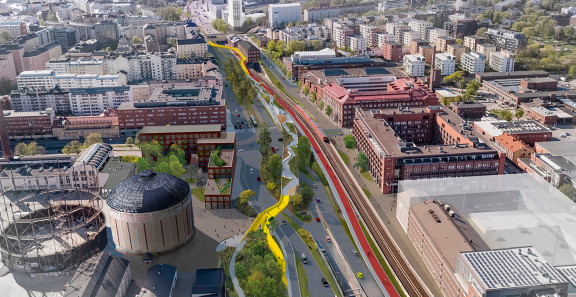In the spring, Sitowise’s architects and landscape architects joined the international Architects Declare initiative. Its aim is to raise awareness and provide the construction industry with new ways of combating climate change and loss of biodiversity.
Architects Declare is based on the knowledge that the construction sector causes almost 40 per cent of global carbon dioxide emissions. Architects Declare was launched in the UK a year ago, and Sitowise joined in the spring. Our aim is to be the most responsible operator in the industry.
“We already adhere to the declaration’s objectives in our everyday work: now we’re just saying it out loud,” says Landscape Architect Aino Karilas, who leads the ecological landscape planning team at Sitowise. She thinks that being backed up by the company is important. “This support gives us the courage to encourage our customers to consider more sustainable solutions.”
Annina Vainio, an architect and urban planner at Sitowise, has noticed that many customers already have both a need and desire to do things differently. “Our task is to actively highlight the various alternatives and ways of realising strategic targets in implementation planning.”
Architects have a grandstand view of the construction sector. Their tasks range from strategic-level planning to regional reviews and design solutions for individual buildings. “For example, the plan for the Tammela block in Tampere examines the carbon footprint of construction, energy production systems, the feasibility of various alternatives, and cityscape issues,” says Architect Eero Puurunen, an environmental consultant at Sitowise.
We already adhere to the declaration’s objectives in our everyday work: now we’re just saying it out loud.
Aino Karilas, Landscape Architect, Ecological Planning Team Manager, Sitowise
The right choices throughout the urban environment’s lifecycle
The declaration seeks to tackle a double global crisis: climate change and a loss of biodiversity. Puurunen thinks that an assessment of lifecycle costs and emissions should be an integral aspect of all project work. “For example, the Kruunusillat alliance calculated the carbon footprint of different structural alternatives during the initial stage of the project.”
Sitowise carries out ecological network analyses for many of its customers, to help them take nature into consideration during urban construction. “We’re currently reviewing the City of Helsinki’s meadow network in collaboration with INARO,” says Karilas. Its functionality from the perspective of, for example, pollinator insects can be improved with natural solutions, such as placing meadows in street environments.”
Architects want to plan cities that are sustainable over the long term. One way of doing this is to utilise and extend the lifecycles of existing buildings. “We think it’s important to repair existing structures whenever possible and whenever it makes more sense than building something new,” says Vainio.
Design competitions are another way to discover alternative solutions. Sitowise’s architects entered their RATA/RAITTI proposal into the Junatie urban design competition that was organised by the City of Helsinki. Its goal was to give pedestrians a highly visible and leading role in the urban environment. “When an old vehicle bridge is converted into a park bridge, black infrastructure will become partially green and the biodiversity of urban nature will increase,” says Vainio.
Pioneers openly share their experiences
One of the declaration’s objectives is to share information about concrete means of achieving its targets. “Workable solutions should be widely and quickly introduced,” says Puurunen. It is equally important to share information on widely recognised measures, such as wooden construction, and to encourage bold experimentation. “Radical change requires both.”
Karilas stresses that actions are most effective when their impacts are monitored, measured and shared. “Together we’ll be able to develop the next generation of solutions.”
Trailblazers will play an important role in the renewal of the construction sector. For example, the City of Helsinki openly shares information about the results of its projects. One good example of this is experimentation with wood species on Reiherintie. “A flowering street arboretum provides us with information on how the range of plants found in cities could be developed in order to better adapt to climate change,” says Karilas.
Architects want to create new design principles that challenge existing practices in the sector. Biodiversity and people’s wellbeing can be improved with, for example, dynamic vegetation. It’s possible to replace segregated mass plantations with vegetation that more closely mimics nature,” says Karilas. Both humans and pollinators will enjoy mixed and multilayered greenery!”
Read more about the topic:
Architects Declare
Junatie design competition
Flowering street arboretum
